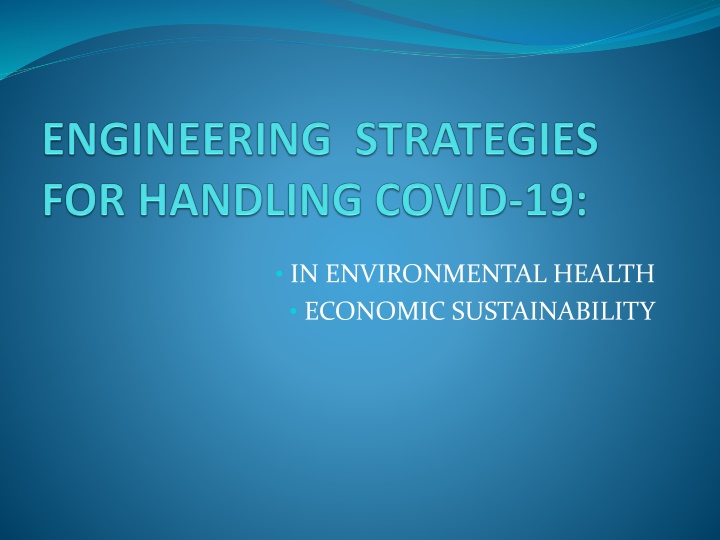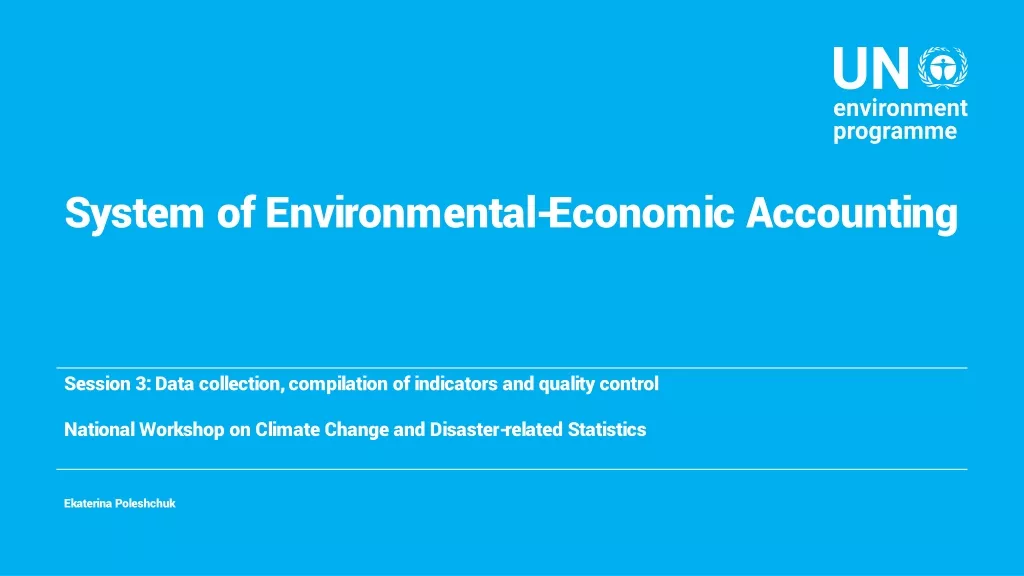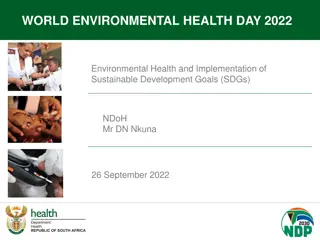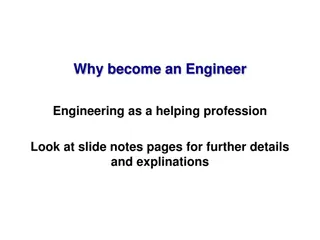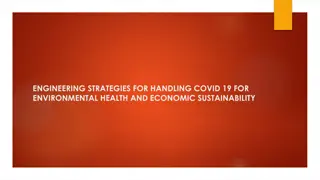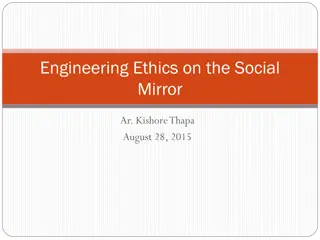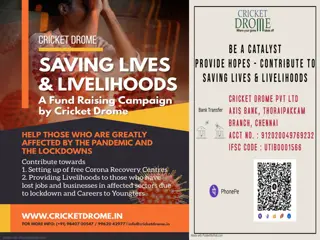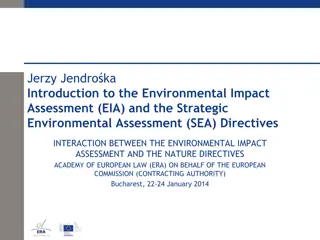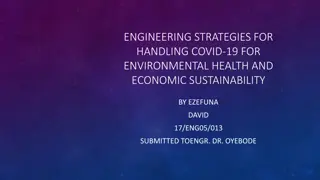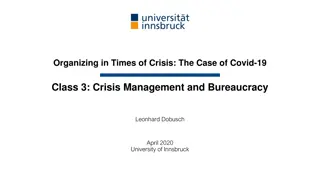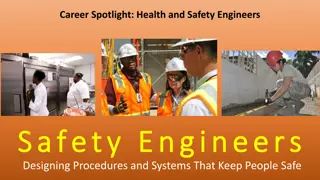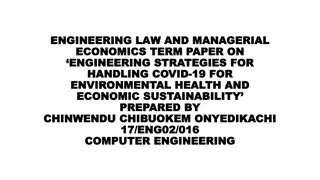Engineers' Role in Environmental Health & Economic Stability Amid COVID-19
This presentation delves into the strategies employed by engineers in environmental health and economic sustainability amidst the global pandemic, COVID-19. Engineers play a critical role in safeguarding human populations from environmental hazards and contributing to sustainable development in various industries. The impact of the pandemic on the economy and environmental health is explored, along with insights into the nature of COVID-19 and its effects on immune cells.
Download Presentation

Please find below an Image/Link to download the presentation.
The content on the website is provided AS IS for your information and personal use only. It may not be sold, licensed, or shared on other websites without obtaining consent from the author.If you encounter any issues during the download, it is possible that the publisher has removed the file from their server.
You are allowed to download the files provided on this website for personal or commercial use, subject to the condition that they are used lawfully. All files are the property of their respective owners.
The content on the website is provided AS IS for your information and personal use only. It may not be sold, licensed, or shared on other websites without obtaining consent from the author.
E N D
Presentation Transcript
IN ENVIRONMENTAL HEALTH ECONOMIC SUSTAINABILITY
As reference to the mentioned topic, this presentation would be concerned in evaluating the strategies employed by engineers in areas of environmental health and economic stability in a world troubled by the global pandemic, COVID- 19. Before the arrival of virus, engineer has played a vital role in shaping the modern world that we live in today. Every industry that provides services and goods to make the life easier and comfortable are all designed and engineered. Such industries are travel, cosmetic, agricultural, housing, entertainment, oil and gas, Medical practicioning etc. ENGINEERS ON ENVIRONMENTAL HEALTH Environmental engineering applies scientific and engineering principles for protection of human populations from the effects of adverse environmental factors
ENGINEERING TO ECONOMY SUSTAINABILITY Engineers play a crucial role in creating infrastructure in the world. Engineers are problem solvers who apply their knowledge and experience to building projects that meet human needs Engineers can contribute to sustainable development along the entire chain of modern production and consumption, including the following:
Designing and building transportation infrastructure Extracting and developing natural resources Processing and modifying resources Producing and distributing energy Recovering and reusing resources Meeting the needs of consumers
EFFECTS OF THE PANDEMIC ON THE ECONOMY & ENVIRONMENTAL HEALTH
UNDERSTANDING COVID-19 Coronaviruses are a group of related viruses that cause diseases in mammalsand birds. In human, coronaviruses cause respiratory tract infections that can range from mild to lethal. The virus particle attaches to the host cell before penetrating it. The virus then uses the host cell s machinery to replicate its own genetic material. Once replication has been completed the virus particles leave the host by either budding or bursting out of the cell (lysis).
The infected cells sends signals to the immune cells(neutrophiles & killer T) that comes to combat the disease to kill the uninfected cells. This singular act throws the immune cells into a frenzy. They begin to kill each other , both the infected and uninfected cells as well.
How to prevent the virus Regularly and thoroughly clean your hands with an alcohol- based hand rub or wash them with soap and water. Maintain at least 1 metre (3 feet) distance between yourself and anyone who is coughing or sneezing Make sure you, and the people around you, follow good respiratory hygiene e.g. covering your mouth when sneezing, disposal of tissue. Follow advice given by your healthcare provider, your national and local public health authority
EFFECT ON GLOBAL ECONOMY It is clear that China will suffer the most. But so will Japan, the Middle East, the US and EU economies along with many other smaller economies. The direct and indirect effects of COVID-19 will worsen this trend. With infections surging, cities in lockdown, businesses downing shutters and most travel on ice, staff layoffs are likely to mushroom. That showed up in the number of Americans filing unemployment benefit claims which hit a record of more than 3 million.
PICTURE OF LOCKDOWN IN THE CITY OF WUHAN This is the current situation in China and several affected countries including Nigeria.
EFFECT ON ENVIRONMENT AND ITS HEALTH As industries, transport networks and businesses have closed down, it has brought a sudden drop in carbon emissions. Compared with this time last year, levels of pollution Globally have reduced by nearly 45% because of measures to contain the virus. In Nigeria, places like Warri, Port harcourt & Lagos that contains more industry have been noticed to have cleaner air as well.
In the U.S., some cities have halted recycling programs as officials worry about the risk of spreading the virus in recycling centers. In particularly hard-hit European nations, waste disposal options have been rolled back. Italy has banned infected residents from sorting their waste at all. Even if the world bounced back from the pandemic, the amount of medical waste left upheaval would be catastrophic. Although these could be used to generate electricity, by engineers.
THIS ENTAILS DEVELOPMENT OF EQUIPMENT AND FACILITIES FOR CONTAINING THE PANDEMIC
WHAT ARE ENGINEERING STRATEGIES? An Engineering Strategydefines how the Engineering organization will meet its objectives. It describes the essential resources and how they will be organized and committed to achieving the objectives. It describes the policies that will apply for the management and use of resources. Most of these Engineering organization are charged with the objective of designing and producing equipments for handling the current pandemic in areas of preserving the environmental health and confining the global/local economic sustainability/development. Some of these equipment for COVID-19 are:
1. ISOLATION ROOMS Many engineer had offers way to manage to air flow in an airborne infection isolation treatment room, using a mixed ventilation system strategy. Mixing typically delivers air into the upper level of the room and uses the momentum of the incoming air to distribute it around the room mixing the clean incoming air and contaminants in the room as it does so. The exhaust duct, usually in the ceiling or behind the patient bed, extracts the mixed air and moves it through a HEPA-filter air purifier before releasing it either outdoors or into a corridor. The filter does not catch the COVID-19 virus but it catches particulates that trap the virus.
A negative air pressure system directs air flow in a room through ventilation that generates pressure lower than the room s surrounding air. Air naturally flows from areas of higher pressure to areas of lower pressure. In AII rooms, the air stays in the room, thanks to the negative pressure, and is exhausted mechanically.
2. N95 RESPIRATORS N95 respirators are the PPE most often used to control exposures to infections transmitted via the airborne route, though their effectiveness is highly dependent upon proper fit and use. The optimal way to prevent airborne transmission is to use a combination of interventions from across the hierarchy of controls, not just PPE alone. Applying a combination of controls can provide an additional degree of protection, even if one intervention fails or is not available. The surgical mask control and filter the air that penetrates it and removes the coronavirus droplets. The method of decontaminating and reuse the respirator that are available in supply. Ultra violent germicidal irritation (UVGI) is a promising method but the disinfection efficacy is dependent on dose.
Taking a look at the design of the respirator reveals that the maks is comprised of 5 filter layer- a 4 m filter cloth, an activated carbon, an efficient filter cloth and an anti-sticking cloth.
STRATEGIES FOR ENVIRONMENTAL HEALTH Planning and risk assessment: COVID-19 outbreaks can have several effects within the workplace. Workers may beabsent from work due to becoming sick, needing to care for others, or from fear of possible exposure. Patterns of commerce may change, both in terms of what goods are demanded, and the means of acquiring these goods (such as shopping at off-peak hours or through deliveryordrive-through services). Lastly, shipments of items from geographic areas severely affected by COVID-19 may be interrupted. Objectives for response to an outbreak include reducing transmission among staff, protecting people who are at higher risk for adverse health complications, maintaining business operations, and minimizing adverse effects on other entities in theirsupply chains.
Engineering controls for this and higher risk groups include installing high-efficiency air filters, increasing ventilation rates, installing physical barriers such as clear plastic sneeze guards, and installing a drive-through window for customer service.
Conclusion I strongly recommend that the awareness of the pandemic to the citizens of Nigeria and thus every citizens who are constantly needed in the industrial sector of the country to keep the economy moving. These engineers should use the respirator and PPE equipment to prevent continous spread.
